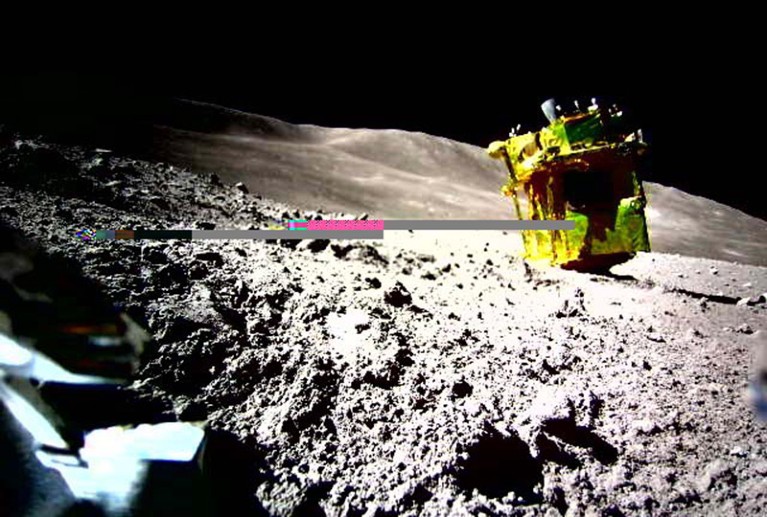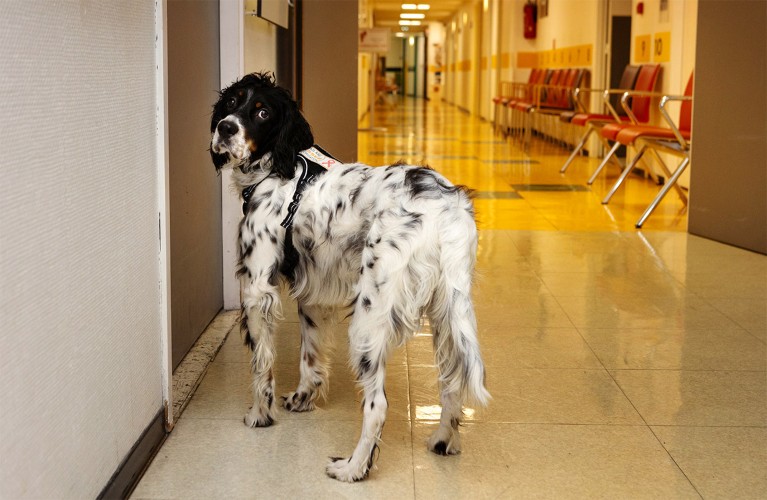Hello Nature readers, would you like to get this Briefing in your inbox free every day? Sign up here.

The lander was photographed upside down on the lunar surface. Credit: JAXA/TOMY Company/Sony Group Corporation/Doshisha
Japan’s lunar lander SLIM has woken up and started operating once again after more than a week without power. During the probe’s descent, one of its engines probably lost thrust and it ended up upside down on the Moon’s surface. Because the SLIM’s solar cells were pointing in the wrong direction, it had to wait for the sunlight angle to change to generate enough power to run communications equipment. The reawakened probe snapped an image of a rock-strewn field and will continue to scan the lunar surface for traces of a mineral called olivine, which could help to answer questions about the Moon’s origin.
Nature | 4 min read
Tiny scraps of genetic material dubbed Obelisks have been discovered in human gut and mouth bacteria. The flattened circles of RNA are even smaller than viruses and too minimalistic to be considered a standard life form, but they can still transmit instructions to cells. Their genetic sequences are very different from similarly shaped RNA structures called viroids that have been found in plants, fungi and animals. Nobody knows how Obelisks might affect human health.
Nature | 5 min read
Reference: bioRxiv preprint (not peer reviewed)
India’s Supreme Court has agreed to hear arguments against a controversial new law that some scientists say makes it easier to clear forests for development and erodes the rights of millions of people. Last year, the 1980 Forest Conservation Act was amended to remove protection from forests that aren’t officially registered and exempt national-security projects from requiring review. “There’s nothing in that act that we can see is going to help nature conservation, food security, ecological security and livelihood,” says co-petitioner M. K. Ranjitsinh Jhala, a former departmental head at the Ministry of Environment and Forests.
Nature | 5 min read
A small study seems to support a controversial hypothesis that proteins related to the neurodegenerative disease can be transferred from person to person through surgical procedures. Out of eight people who in childhood had received growth hormone derived from cadavers (a practice that no longer exists), five later met the diagnostic criteria for early-onset Alzheimer’s disease. The researchers suggest that amyloid-beta protein, which was present in the hormone preparations, was ‘seeded’ in the brains and caused the damage. This doesn’t suggest Alzheimer’s disease can be contagious. Critics highlight that the study’s small size limits the strength of the findings and question whether the people actually had Alzheimer’s disease.
Nature | 5 min read
Reference: Nature Medicine paper
Features & opinion
Co-working labs — flexible rental spaces with shared equipment and consumables — are becoming the preferred home for many biotech start-ups. Renting means companies don’t have to spend time and money creating their own labs straight away. And a supportive community of experienced innovators and mentors can cushion the journey to commercial development. “It’s nice not working in isolation,” says Lin Zhaoru, co-founder and chief operating officer of a small reagents manufacturer.
Nature | 11 min read
Mothers in science are pushing for radical changes that would make academia truly fair. The system must lose its hostile attitude towards those who do not follow a direct career path, says molecular biologist Fernanda Staniscuaski. Like many mothers, she was almost pushed out of academia after taking breaks for parental leave. In Brazil, the movement has achieved concrete results, including a career-restart grant for mothers and a change in how scholarship applicants’ productivity is evaluated. “The struggle for change spearheaded by mothers yields benefits for the entire academic community,” Staniscuaski says.
Nature | 5 min read
Children lost in the wilderness are usually found less than two kilometres from their last known location while hikers tend to follow streams downhill — these are some of the insights from the field of lost-person behaviour. Researchers continue to refine their models to account for the various ways people try to get themselves un-lost. But trying new strategies isn’t usually on top of rescue teams’ priorities, because what they have tends to work. “When there is a time-sensitive thing like a search on, they probably aren’t super confident to go, ‘Okay, well, let’s use this new technology’,” says geospatial researcher Krystal Dacey. “They’re like, ‘Let’s do what we’ve always done.’”
Undark | 17 min read
Where I work

Snoopy and Marguerite Nicodeme are health-care workers at the Curie Institute in Paris.Credit: Julie Glassberg for Nature
Snoopy’s main tasks as an ‘employee’ at the Curie Institute in Paris are to cheer up patients and to keep up the morale of the hospital workers. “I don’t think he considers it work,” says nurse practitioner Marguerite Nicodeme, the three-year-old English Setter’s colleague since 2022. “He’s so happy to come in and say hello to everyone. Having chemotherapy isn’t a pleasant experience, but Snoopy helps to make it that little bit more bearable.” (Nature | 3 min read)
Today, I was delighted to see two rats taking selfies in return for treats. Photographer Augustin Lignier trained the animals to push a button that snaps a picture, which was then displayed on a screen for the rats to see. “But honestly I don’t think they understood it,” Lignier says.
Thanks for reading,
Katrina Krämer, associate editor, Nature Briefing
With contributions by Flora Graham, Gemma Conroy and Sarah Tomlin
Want more? Sign up to our other free Nature Briefing newsletters:
• Nature Briefing: Anthropocene — climate change, biodiversity, sustainability and geoengineering
• Nature Briefing: AI & Robotics — 100% written by humans, of course
• Nature Briefing: Cancer — a weekly newsletter written with cancer researchers in mind
• Nature Briefing: Translational Research covers biotechnology, drug discovery and pharma
